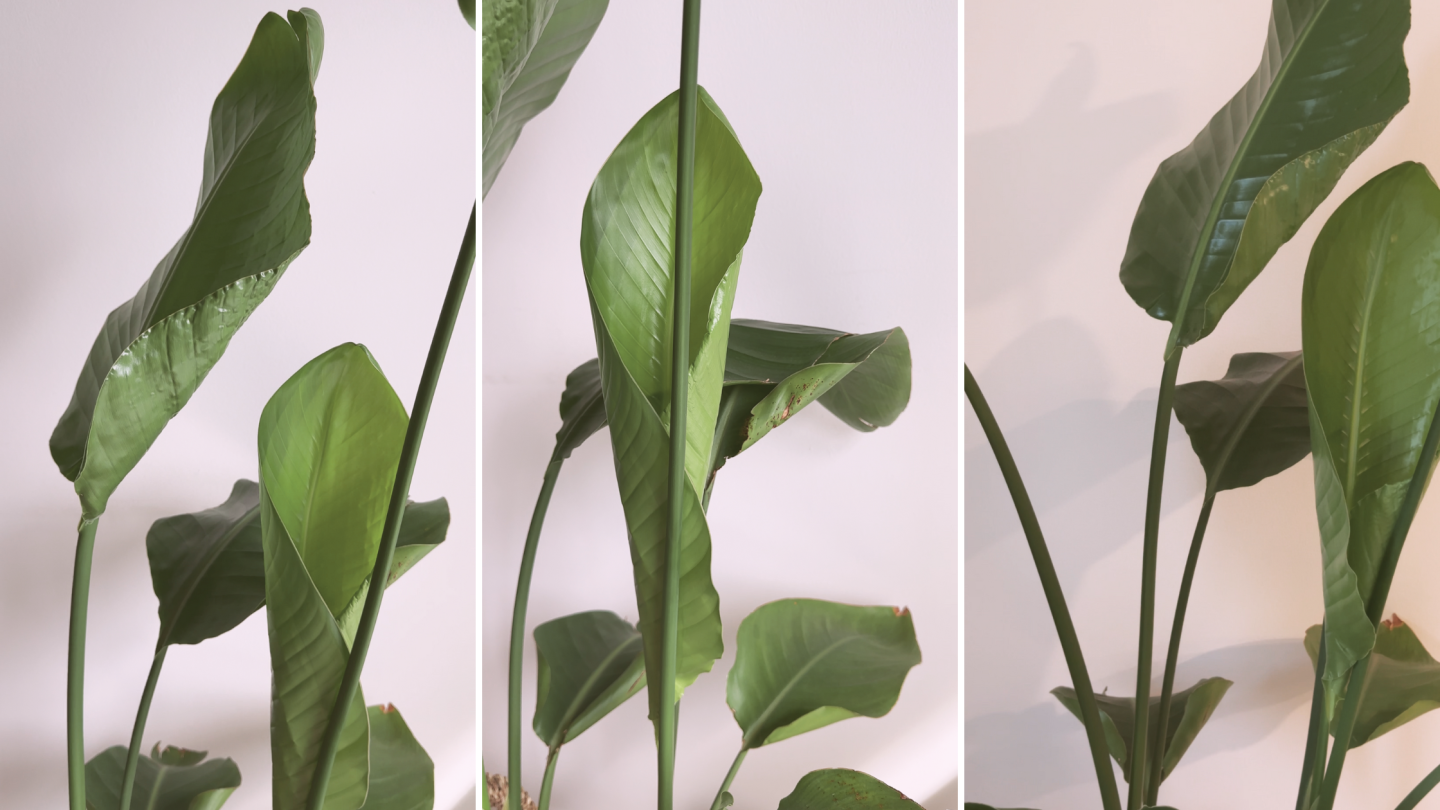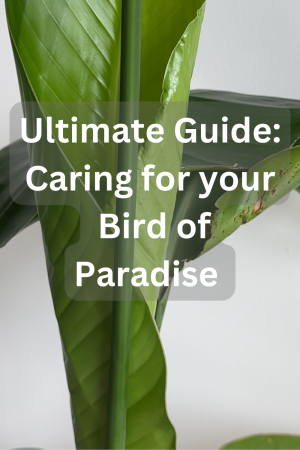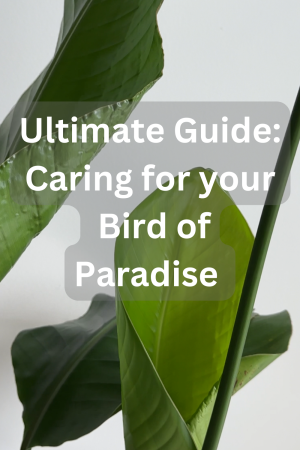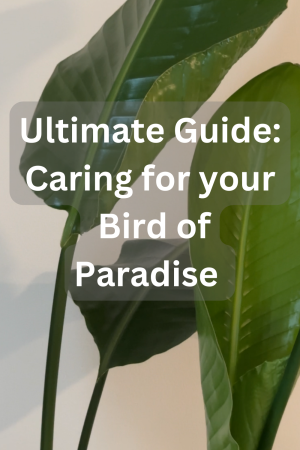
One of my all time favorites house plants that I own is my bird of paradise plant. I’ve had my bird of paradise with me for 3 year and it has survived 3 apartment moves with me! My plant was given to me as a gift and I try my best to keep it happy and healthy. Anyways, I put together this post of how to have a happy, healthy, ad thriving bird of paradise indoor plant! Let’s waste no time and get to how to care for your bird of paradise!
What is the Bird of Paradise?
I love learning about where my houseplants originate because it can give you a good idea on what to expect when caring for you plant at home. The birds of paradise plant known as Strelitzia reginae. is native to South Africa. They are indigenous to the eastern parts of the country, particularly in the provinces of Eastern Cape and KwaZulu-Natal.
Bird of Paradise Light Requirements
Knowing the correct lighting requirements can make or break how happy your bird of paradise is. For indoor light requirements of birds of paradise they prefer bright indirect light. It’s best to place them near a bright window but try to avoid direct sun light as this on burn their leaves.
Bird of paradise can tolerate low light bit the growth will be slower and your plant my not flower. If you’re concerned about low light levels you can look into get LED grow lights for your plants to compensate for the lack of light.

Bird of Paradise Water Requirements
Just like like light watering is also an essential component to bird of paradise care. You can’t slack on either side because your plant will let you know one way or another!
- Moderate Moisture: Bird of Paradise plants prefer soil that is consistently moist but not waterlogged. Aim to keep the soil evenly moist during the growing season, allowing the top inch or so of soil to dry out slightly between waterings. In winter or during periods of dormancy, reduce watering frequency to prevent waterlogged soil.
- Avoid Overwatering: Bird of Paradise plants are susceptible to root rot if they are overwatered. Make sure the pot has proper drainage holes, and avoid allowing excess water to accumulate in the saucer beneath the pot. Always check the soil moisture level before watering to prevent waterlogging.
- Watering Frequency: The frequency of watering will depend on factors such as temperature, humidity, and the size of the plant. In general, water Bird of Paradise plants when the top inch of soil feels dry to the touch. Adjust watering frequency as needed based on environmental conditions.
- Watering Method: When watering, thoroughly saturate the soil until water begins to drain from the bottom of the pot. Allow excess water to drain away, and empty the saucer beneath the pot to prevent water from standing. Avoid wetting the foliage excessively, as this can promote fungal diseases.
More Plant Posts
Are Satin Pothos Easy To Care For? Propagation +(Scindapsus Pictus Care)
Nurturing Growth: A Complete Guide to Successful Plant Repotting
The Green Secret to Happy Houseplants: Houseplant Humidifiers
Learn How to Care for the Philodendron Brasil
Bird of Paradise Humidity Requirements
I believe humidity can be challenging part of any houseplant care, but the Bird of Paradise plants generally prefer moderate to high humidity levels, replicating the humid conditions of their native tropical habitats. Here are some guidelines for managing humidity for Bird of Paradise care:
- Indoor Humidity: When growing Bird of Paradise plants indoors, it’s essential to maintain moderate to high humidity levels, especially in environments with dry air. Aim for humidity levels between 50% to 70% if possible. You can increase indoor humidity by using a room humidifier, placing a humidity tray filled with water and pebbles beneath the plant’s pot, or grouping plants together to create a microclimate of higher humidity.
- I personal opt for a humidifier that I use a couple times a week on my plant
- Misting: Regularly misting the foliage of Bird of Paradise plants can help increase humidity around the plant. Use a spray bottle to mist the leaves with room temperature water, especially during dry periods or in heated indoor environments. Avoid misting the flowers directly, as this can cause damage or promote fungal diseases.
- Location: Consider the location when placing Bird of Paradise plants indoors. Avoid placing them near heating vents, air conditioners, or drafty windows, as these can contribute to lower humidity levels. Instead, choose a location with stable temperatures and indirect sunlight.
If you’re interesting in learning more about humidifiers for your houseplants. Click the link to read my blog post.
Signs of Overwatering a Bird of Paradise
Proper watering is essential to appropriate bird of paradise care. One easy mistake is overwatering your plant. Overwatering can be detrimental to Bird of Paradise plants (Strelitzia spp.), leading to root rot and other issues. Here are some signs that your Bird of Paradise may be suffering from overwatering:
- Yellowing or Wilting Leaves: Overwatering can cause the leaves of Bird of Paradise plants to turn yellow or wilt. This is often due to the roots becoming waterlogged and unable to take up oxygen, leading to poor nutrient uptake and plant stress.
- Soft or Mushy Roots: When you gently pull the plant out of its pot, check the roots. If they appear soft, mushy, or have a foul odor, it’s a sign of root rot, which can be caused by overwatering.
- Leaf Drop: Overwatered Bird of Paradise plants may drop leaves as a response to stress. If you notice excessive leaf drop, especially if it’s accompanied by yellowing or browning of the leaves, it could indicate overwatering.
- Stunted Growth: Overwatering can inhibit the growth of Bird of Paradise plants. If your plant seems to be growing slowly or not at all, despite adequate light and nutrients, overwatering may be the culprit.
- Mold or Fungus Growth: Excessive moisture in the soil can create conditions favorable for mold, mildew, or fungus growth. If you notice any white or fuzzy growth on the soil surface or near the base of the plant, it could indicate overwatering.
- Soggy Soil: Check the soil moisture level by inserting your finger into the soil. If it feels consistently wet or soggy several inches below the surface, it’s a sign of overwatering. Bird of Paradise plants prefer soil that is evenly moist but not waterlogged.
If you suspect that your Bird of Paradise plant is suffering from overwatering, it’s essential to take corrective action promptly. You must allow the soil to dry out partially before watering again, and consider adjusting your watering frequency or improving drainage to prevent future issues. Additionally, if root rot is present, you may need to trim away affected roots and repot the plant in fresh, well-draining soil.
Signs of Underwatering a Bird of Paradise
Just as overwatering a bird of paradise can be deterimental to your bird of paradise care. Underwatering can also have negative effects on Bird of Paradise plants (Strelitzia spp.). Here are some signs that your Bird of Paradise may be underwatered:
- Wilting Leaves: If your Bird of Paradise is not receiving enough water, its leaves may start to wilt and become limp. This is the plant’s way of conserving water and reducing surface area to minimize moisture loss.
- Yellowing or Browning Leaves: Underwatered Bird of Paradise plants may develop yellow or brown tips and edges on their leaves. This is often due to dehydration and lack of sufficient water uptake.
- Dry, Crispy Leaves: The leaves of an underwatered Bird of Paradise may become dry, crispy, or brittle to the touch. This is a sign that the plant is not receiving enough water to maintain its turgidity.
- Slow Growth: Insufficient water can slow down the growth rate of Bird of Paradise plants. If you notice that your plant is not growing as vigorously as it should, despite adequate light and nutrients, underwatering may be the cause.
- Leaf Drop: In severe cases of underwatering, Bird of Paradise plants may drop their leaves as a survival mechanism. This is the plant’s way of reducing water loss through transpiration when water availability is limited.
- Shriveled or Wrinkled Stems: Lack of water can cause the stems of Bird of Paradise plants to become shriveled or wrinkled. This is a sign of severe dehydration and stress.
If you suspect that your Bird of Paradise plant is underwatered, it’s essential to address the issue promptly to prevent further damage. Here are some steps you can take:
- Water the plant thoroughly, ensuring that the soil is evenly moist but not waterlogged.
- Check the soil moisture regularly and adjust your watering schedule as needed to keep the soil consistently moist.
- Consider the environmental conditions, such as temperature and humidity, which can affect the plant’s water requirements.
- Monitor the plant closely for signs of recovery, such as improved leaf turgidity and new growth.
By providing adequate water and addressing any underlying issues, you can help your Bird of Paradise plant recover and thrive.

Bird of Paradise Temperature Requirements
Bird of Paradise plants (Strelitzia spp.) generally prefer warm temperatures and can be sensitive to cold. Here are some temperature requirements for Bird of Paradise plants:
- Ideal Temperature Range: Bird of Paradise plants thrive in temperatures ranging from 65°F to 85°F (18°C to 29°C). They prefer temperatures on the warmer side but can tolerate slightly cooler temperatures as long as they are not exposed to frost or freezing temperatures.
- Avoid Cold Drafts: Bird of Paradise plants are sensitive to cold drafts, so it’s essential to avoid placing them near drafty windows, doors, or air conditioning vents. Cold drafts can cause stress to the plant and lead to issues such as leaf damage or stunted growth.
- Winter Care: During the winter months, when temperatures drop, it’s crucial to protect Bird of Paradise plants from cold temperatures. If growing outdoors in temperate regions, consider bringing potted plants indoors or providing protective coverings during frosty nights. Indoors, avoid placing plants near cold windows or heating vents.
- Temperature Tolerance: While Bird of Paradise plants prefer warm temperatures, they can tolerate short periods of slightly cooler temperatures, especially if they are acclimated gradually. However, prolonged exposure to temperatures below 50°F (10°C) can cause damage to the plant.
- Consistent Temperatures: Bird of Paradise plants prefer stable and consistent temperatures. Avoid drastic temperature fluctuations, as these can stress the plant and affect its growth and overall health.
By providing the appropriate temperature conditions, you can help ensure that your Bird of Paradise plant remains healthy and thrives in its environment. Monitoring temperature levels and protecting the plant from cold drafts are essential practices for caring for Bird of Paradise plants, especially in regions with fluctuating weather patterns.
Bird of Paradise Care Soil Requirements
Now one of the most basic parts of plant care is getting the correct soil! Soil requirements for Bird of Paradise plants (Strelitzia spp.) are crucial for their overall health and growth. Here are some key considerations for selecting and maintaining soil for Bird of Paradise plants:
- Well-Draining Soil: Bird of Paradise plants prefer soil that is well-draining to prevent waterlogging, which can lead to root rot. Choose a high-quality potting mix specifically formulated for tropical plants or mix your own using equal parts of peat moss, perlite, and coarse sand.
- Aeration: The soil should be loose and aerated to allow oxygen to reach the roots. Avoid compacted or heavy soils that can suffocate the roots and hinder drainage. Incorporating organic matter such as compost or well-decomposed manure can improve soil structure and aeration.
- pH Level: Bird of Paradise plants prefer slightly acidic to neutral soil with a pH range between 6.0 and 7.0. Test the pH of the soil using a soil pH meter or test kit and amend the soil as needed to adjust pH levels within the optimal range.
- Nutrient-Rich: While Bird of Paradise plants are not heavy feeders, they benefit from a soil mix that is rich in organic nutrients. Adding a slow-release fertilizer or incorporating compost into the soil can provide essential nutrients for healthy growth and flowering.
- Container Size: When growing Bird of Paradise plants in containers, choose pots with adequate drainage holes and a size that allows for sufficient root growth. Repotting may be necessary every 2-3 years to refresh the soil and provide more space for root expansion.
- Moisture Retention: While it’s essential for the soil to be well-draining, it should also retain some moisture to keep the roots hydrated. Avoid soils that dry out too quickly or become excessively dry between waterings. Adding organic matter such as peat moss or coconut coir can help improve moisture retention.
- Avoid Waterlogged Soil: Ensure that excess water can drain freely from the soil to prevent waterlogging, which can lead to root rot and other issues. Use pots with drainage holes, and avoid allowing water to accumulate in the saucer beneath the pot.
By selecting and maintaining the right soil conditions, you can help ensure that your Bird of Paradise plant remains healthy and thrives in its environment. Regular monitoring of soil moisture and pH levels, along with proper watering and fertilization, are essential practices for caring for Bird of Paradise plants.
How to Fertilize Bird of the Paradise
Fertilizing Bird of Paradise plants (Strelitzia spp.) is important to provide them with essential nutrients for healthy growth and flowering. Here are some guidelines for fertilizing Bird of Paradise plants effectively:
- Frequency: Bird of Paradise plants benefit from regular fertilization during the growing season, typically from spring through early fall. Reduce or suspend fertilization during the winter months when the plant’s growth slows down.
- Type of Fertilizer: Use a balanced, water-soluble fertilizer formulated for tropical plants or flowering plants. Look for a fertilizer with an N-P-K ratio (nitrogen, phosphorus, potassium) of around 10-10-10 or similar. Alternatively, you can use a slow-release fertilizer designed for outdoor plants, applying it according to the manufacturer’s instructions.
- Application Method: Dilute the fertilizer according to the instructions on the packaging, and apply it to the soil around the base of the plant. Water the plant thoroughly after fertilizing to ensure that the nutrients are distributed evenly and to prevent fertilizer burn.
- Frequency of Application: Apply fertilizer every 4-6 weeks during the growing season, following the dosage recommendations on the fertilizer packaging. Avoid overfertilizing, as this can lead to nutrient imbalances and damage to the plant.
- Additional Considerations: If your Bird of Paradise plant is not producing flowers, you may want to use a fertilizer with a higher phosphorus content to promote blooming. Follow the recommended application rates to avoid overstimulating foliage growth at the expense of flowers.
- Organic Options: If you prefer organic fertilizers, you can use compost or well-decomposed manure as a nutrient-rich soil amendment. Apply compost or manure around the base of the plant, ensuring that it is well-incorporated into the soil.
- Monitoring: Monitor the plant for signs of nutrient deficiencies or excesses, such as yellowing leaves or stunted growth. Adjust your fertilization regimen accordingly based on the plant’s response and overall health.
More Plant Posts
Are Satin Pothos Easy To Care For? Propagation +(Scindapsus Pictus Care)
Nurturing Growth: A Complete Guide to Successful Plant Repotting
The Green Secret to Happy Houseplants: Houseplant Humidifiers
Learn How to Care for the Philodendron Brasil
How to Repot a Bird of Paradise
An overlooked part of any plant care is repotting (my link to my repotting houseplant guide!)! Repotting a Bird of Paradise plant is essential for its health and continued growth, especially when it becomes root-bound or outgrows its current container. Here’s a step-by-step guide on how to repot a Bird of Paradise:
- Choose the Right Time: The best time to repot a Bird of Paradise plant is in the spring or early summer when it’s actively growing. Avoid repotting during the dormant winter months.
- Select a New Pot: Choose a new pot that is slightly larger than the current one. Ensure the new pot has drainage holes at the bottom to prevent waterlogging, which can lead to root rot.
- Prepare Potting Mix: Use a well-draining potting mix suitable for tropical plants. You can mix equal parts of peat moss, perlite, and compost to create a suitable medium.
- Preparation: Water the plant thoroughly a day or two before repotting. This will help loosen the root ball and reduce transplant shock.
- Remove the Plant: Carefully tilt the pot on its side and gently tap the pot’s bottom to loosen the root ball. Once the plant is loosened, carefully lift it out of the pot. Be gentle to avoid damaging the roots.
- Inspect and Prune Roots: Inspect the root ball for any signs of rot or damage. Trim away any dead or damaged roots using clean and sharp pruning shears.
- Prepare the New Pot: Add a layer of fresh potting mix to the bottom of the new pot. Make a small mound in the center to support the plant’s root ball.
- Replant the Bird of Paradise: Place the plant in the center of the new pot, ensuring it sits at the same level as it did in the previous pot. Fill the remaining space around the root ball with fresh potting mix, gently pressing it down to secure the plant.
- Watering and Care: After repotting, water the plant thoroughly until excess water drains out of the bottom. Keep the soil evenly moist in the following weeks, but avoid overwatering. Place the plant in a location with bright, indirect sunlight.
- Post-repotting Care: To minimize stress, avoid fertilizing the plant for a few weeks after repotting. Monitor the plant closely for signs of stress, such as wilting or yellowing leaves, and adjust care accordingly.
By following these steps, you can successfully repot your Bird of Paradise plant and provide it with a healthy environment for continued growth! YAY for healthy bird of paradise!

Common Bird of Paradise Pests
The Bird of Paradise, like many other houseplants, can be susceptible to a few common pests. Here are some of the most common pests that may affect your Bird of Paradise care:
- Spider Mites: These tiny pests are common on indoor plants, including Bird of Paradise. They feed on plant sap, causing leaves to turn yellow, dry out, and drop prematurely. You may notice fine webbing on the leaves and stems. Spider mites thrive in dry conditions, so increasing humidity and regularly misting the plant can help deter them.
- Aphids: Aphids are small, soft-bodied insects that feed on plant sap. They can be found clustered on the undersides of leaves or along stems. Aphids cause leaves to curl, yellow, and distort growth. You can control aphids by spraying the plant with a strong stream of water to dislodge them or by using insecticidal soap.
- Scale Insects: Scale insects appear as small, raised bumps on the stems and leaves of the plant. They feed on plant sap and excrete honeydew, which can attract ants and promote the growth of sooty mold. You can manually remove scale insects with a soft brush or cloth dipped in rubbing alcohol. Insecticidal soap or horticultural oil can also help control scale infestations.
- Mealybugs: Mealybugs are soft-bodied insects covered in a white, cottony substance. They feed on plant sap, causing leaves to yellow and distort. Mealybugs can be found on the undersides of leaves, along stems, and in leaf axils. You can remove mealybugs by dabbing them with a cotton swab dipped in rubbing alcohol or by spraying the plant with insecticidal soap.
- Thrips: Thrips are tiny, slender insects that feed on plant tissue by puncturing the surface and sucking out the contents. They can cause leaves to become discolored, distorted, and stippled. Thrips are often found on the undersides of leaves. You can control thrips with insecticidal soap or neem oil.
Regularly inspecting your Bird of Paradise plant for signs of pests and promptly addressing any infestations can help keep your plant healthy and thriving. Additionally, practicing good plant hygiene, such as removing dead or diseased plant material and avoiding overwatering, can help prevent pest problems. That’s all for now! Leave a comment if you found this bird of paradise care guide helpful or if you have any other questions I can help you with!
